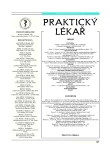Assessment of the opinions of general practitioners in the Czech Republic on the therapeutic strategy in hypertension. Results of the third stage of the DRIVE survey
Posouzení názorů praktických lékařů v České republice na strategii léčby hypertenze Výsledky 3. fáze průzkumu DRIVE
Cílem této práce bylo zjištění názorů praktických lékařů na léčbu hypertenze. Průzkum DRIVE proběhl v České republice v ordinacích 119 praktických lékařů v době od ledna do června 2004. V 10 otázkách byli praktičtí lékaři dotazováni na diagnostiku, zahájení léčby a léčebnou strategii u pacientů s hypertenzí, jednak ve skupině „mladších hypertoniků“ ve věku 40–60 let, jednak ve skupině „starších hypertoniků“, tj. ve věku 70 a více let.
Výsledky ukázaly, že jen 40,5 % lékařů zahajuje léčbu hypertenze při zvýšení systolického tlaku v rozmezí 140–149 mm Hg. U starších pacientů pak je to dokonce jen 17,5 %. Plných 38,8 % lékařů zahajuje léčbu teprve při úrovni systolického tlaku 150–159 mm Hg a 15,5 % lékařů zahajuje léčbu teprve při úrovni systolického tlaku 160 mm Hg a vyšší.
Situace u starších hypertoniků je statisticky významně horší (p<0,001); dokonce více než jedna třetina lékařů zahajuje léčbu teprve při zvýšení systolického tlaku na hodnoty 160 mm Hg a vyšší.
U pacientů s diabetem se snaží být praktičtí lékaři v léčbě hypertenze energičtější. Celkem 40,5 % lékařů zahajuje léčbu již při úrovni systolického tlaku 130–139 mm Hg, oproti pouze 5,3 % u hypertoniků bez diabetu.
Pouze 9,5 % lékařů zahajuje léčbu při úrovni systolického tlaku 150–159 mm Hg (oproti 38,8 % u hypertoniků bez diabetu) a jen 2,6 % zahajuje léčbu hypertenze při úrovni systolického tlaku ≥160 mm Hg (oproti 15,5 % u hypertoniků bez diabetu). Nicméně i u diabetiků jsme zjistili významně nižší agresivitu léčby systolického tlaku u osob ≥70letých oproti mladším hypertonikům (p<0,001).
Z údajů o nejpoužívanějších antihypertenzivech vyplývá stále přetrvávající obava z betablokátorů u starších osob. Jejich kardioprotektivní účinek, především u současně přítomné ICHS, není ve stáří menší, ale vzhledem k vyššímu absolutnímu riziku naopak vyšší. Porovnání léčby hypertenze u 2 kazuistik z dotazníkové akce v USA stejného typu ukazuje, že v léčbě systolické hypertenze jsou praktičtí lékaři více agresivní. Z dotazníků se jeví zřetelně, že nejhůře je léčena mírná systolická hypertenze starších osob.
Klíčová slova:
názory praktických lékařů o léčbě hypertenze – hypertenze při diabetes mellitus.
Authors:
J. Widimský 1; M. Sachová 2; V. Lánská 3
Authors‘ workplace:
Klinika kardiologie IKEM, Praha
1; Servier s. r. o., Praha
2; Úsek náměstka pro odbornou činnost, IKEM, Praha
3
Published in:
Prakt. Lék. 2005; 85(6): 354-357
Category:
General Medicine
Overview
The objective of this paper was the identification of opinions among general practitioners (GPs) on the treatment of hypertension. The DRIVE survey has been conducted in the offices of 119 GPs over the period of November 2003 through April 2004. In ten questions the GPs were asked about the diagnostics, onset of treatment, and the therapeutic strategy in patients suffering from hypertension, on the one hand in a group of „young hypertonics” 40–60 years old, and in a group of „elder hypertonics”, i.e. of 70 years or more, on the other.
The results have shown that only 40.5% of physicians initiate treatment of systolic pressure increased to 140–149 mm Hg. In elder patients it is only 17.5%. A whole 38.8% of physicians begin treatment until the systolic pressure level reaches 150–159 mm Hg, and 15.5% begin treatment at the level of systolic blood pressure 160 mm Hg and more.
The situation in elder hypertonic patients is worse to a statistically significant degree (p<0.001); even more than one-third of physicians begin treatment at systolic blood pressure level of 160 mm Hg and more.
In patients with diabetes mellitus, physicians try to be more agressive in treating hypertension. In all, 40.5% physicians begin therapy at a systolic pressure of 130–139 mm Hg as against only 5.3% in hypertonics without diabetes. Only 9.5% physicians begin therapy at the systolic pressure level of 150–159 mm Hg (as against 38.8% in hypertonics without diabetes), and only 2.6% begin treatment of hypertension at the systolic pressure level of ≥ 160 mm Hg (as against 15.5% in hypertonics without diabetes). Nevertheless, even in diabetic patients we have found a significantly lower aggressiveness in the therapy of systolic pressure in patients >70 years old as against younger hypertonics (p<0.001).
From data on the most frequently applied anti-hypertensive drugs there follows a still persevering fear of beta-blockers in the elderly. Their cardioprotective effect, namely in simultaneously present IHD is not lower in old age, but in view of the higher absolute risk, to the contrary it is higher.
Comparison of treatment of hypertension in two case reports from a questionnaire survey in the USA of the same type shows that our GPs are more aggressive in the treatment of systolic hypertension.
From the questionnaires it follows clearly that moderate systolic hypertension in the elderly appears to be the worst treated.
Key words:
Opinions of general practitioners – treatment of hypertension – hypertension in diabetes mellitus.
Labels
General practitioner for children and adolescents General practitioner for adultsArticle was published in
General Practitioner

2005 Issue 6
- Metamizole vs. Tramadol in Postoperative Analgesia
- Metamizole at a Glance and in Practice – Effective Non-Opioid Analgesic for All Ages
- Hope Awakens with Early Diagnosis of Parkinson's Disease Based on Skin Odor
- Advances in the Treatment of Myasthenia Gravis on the Horizon
- Metamizole in perioperative treatment in children under 14 years – results of a questionnaire survey from practice
Most read in this issue
- The principle of dual effect and conscience
- Defecography in the diagnostics of anorectal dysfunctions
- Clinical significance of vitamin K for quality of bone and for calcified tissues
- Atypical course of type A thoracic aortal dissection in a pregnant woman
